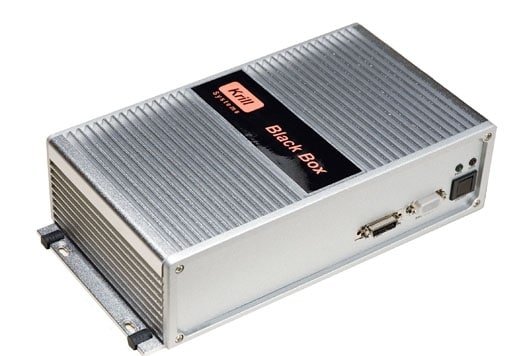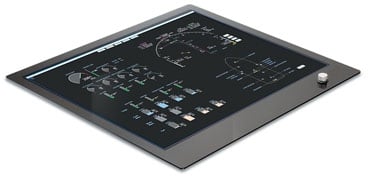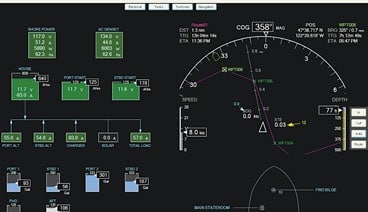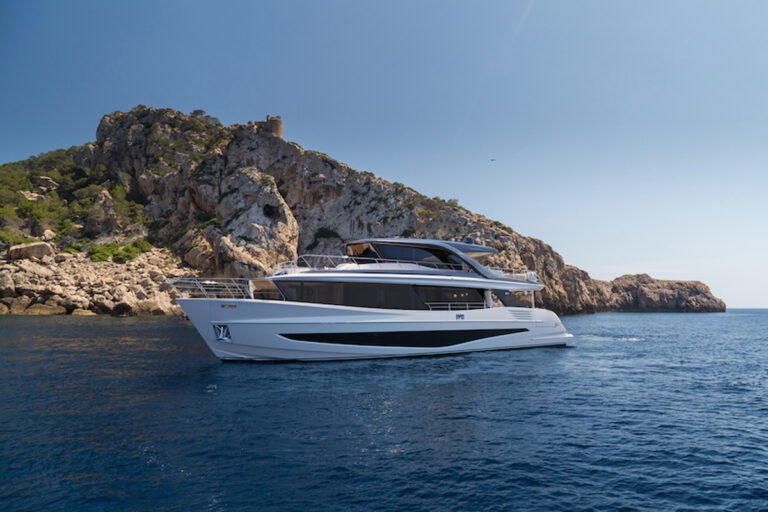
yctelectapr1.jpg
I stepped aboard the comely 75-foot Northern Marine expedition yacht Cheemaun in her marina in Jacksonville, Florida, and instantly realized she was having some work done. Doors and hatches were flung open throughout the boat and I could hear the voices of technicians from Atlantic Coast Marine (ACM) Electronics, a local service provider, in the engine compartment. Casey Cox, president of Krill Systems, ushered me up to the pilothouse, command center for this operation-which was to install his company’s custom vessel monitoring system on board Cheemaun. The new cutting-edge Krill Systems would draw data from 46 different sensors that ACM’s team was installing throughout the yacht and display it on a single monitor at the helm. “You’d be amazed how many boats don’t have anything like this all in one place,” Cox said.
Launched by Northern Marine in 1998 as Starship for a German owner who took her around the world, her last owner had been legendary actor Gene Hackman. Now, she was in the hands of an owner who clearly wanted her to be the best, safest and most up-to-date vessel she could be. When her new vessel monitoring system was fully up and running, she would be taking another ground-breaking voyage-not around the world, but into her own inner space.
How It Works
Cox’s Krill Systems are deceptively simple. The individual sensors measure everything from engineroom temperature to fuel tank levels to battery loads. The owner of Cheemaun, in fact, requested one be installed in the boat’s air horn so he can monitor the air pressure level. The sensors are linked by cable to sensor pods mounted in compact arrays. On Cheemaun, which has seven pods, Cox and ACM mounted four of them in the engineroom and found space for the other three on the back of an existing cabinet door above the yacht’s electrical distribution panel. The sensor input is converted into digital data and sent via an ethernet connection from the sensor pods to a central ethernet switch. From there, it is routed to the owner’s choice of monitors, where all the information is displayed onscreen in a highly readable array. Krill Systems offers the DU840 sunlight-readable fixed monitor, but also can send the data to any PC-based display. Cheemaun already was equipped with three large ProView screens at the helm, so Cox simply sent the information there.

| | |
If you install a wireless router like the ones found in today’s home offices, the vessel monitoring data also can be transmitted remotely to multiple “Soft Displays” anywhere on the boat. Better yet, it can be sent by Internet to the owner’s office and home PC, solving the universal dilemma of what would happen if a bilge or smoke alarm goes off on board with no one around to hear it. Since you can mount sensors on the boat’s doors and windows, the vessel monitoring system also functions as a security device. Custom Krill Systems installations range in price from $7,000 to about $18,000, depending on the size of the boat, the number of sensors and the plug-and-play features the owner wants to include.
The Man Behind The Curtain
**** Like many innovative marine entrepreneurs, Cox was a boater first. A former vice president of engineering for Copper Mountain Networks who worked in DSL telephone systems technology, he owned a 45-foot Jeanneau sailboat for recreation. After embarking on a cruise from San Francisco to Alaska with his wife and twin children, a life-altering event occurred. “When we got to Seattle, the family mutinied,” he explained. “They said, ‘We don’t want to go upwind any more.'” They parked the boat and settled in Seattle. Cox decided to create his own vessel management system, addressing some of the frustrations he’d had with his sailboat’s equipment when it came to keeping watch over systems and detecting minor problems before they became major headaches.
“I wanted everything together in a nice, clean screen,” he said. His Krill Systems display has a combination of analog and digital readouts. “Analog gives you a quick, at-a-glance reading; digital is precise,” he said. “You need both to show you what’s really going on.”
The Krill Systems monitor at Cheemaun’s helm was packed with information, but it was arranged in a clear, easy-to-read array. Cox says the layout was inspired by avionics heads-up displays, “But instead of the altitude, it shows the depth of the water beneath you.” On Cheemaun’s screen, analog displays are to the right, with the compass heading, speed and depth at the top, per the owner’s request. Beneath them is a schematic of the yacht with the alarm sensors displayed. Digital readouts from all the electrical systems and the various on board tanks are on the left-hand side of the screen.
Installation
**** In order to install the Krill System sensors properly, technicians have to recalibrate the tanks that the owner wants to monitor on board. Sometimes, the process uncovers hidden secrets. ACM’s team discovered that the placard listing fuel capacity on Cheemaun’s fuel tank was about 300 gallons too generous. “This owner is a stickler- he wants to know exactly to the last gallon what he has,” said Dave DeVos, the owner of AMC.
Krill Systems supplies all the sensors and the wiring for the system as part of the installation package. “That way, we know it’s going to work,” Cox said. He works closely with the electronics company on every installation, especially if it’s the installer’s first Krill Systems project. “There was a bit of a learning curve, but it wasn’t extremely difficult,” DeVos said.
Made To Order
After installation, the beauty of the system is that the boat owner can have new features added and program them himself. Cox gave me a demonstration. In about 10 seconds, with just a few keystrokes, I was able to add a new tank to the system-a propane tank for a phantom barbecue. The tank graphic displaying the propane level popped right up on the screen. I even was able to place it where I wanted in the display. DeVos’ team was recalibrating Cheemaun’s freshwater tank (also wrongly labeled), and I entered the next calibration point into the system. This was easy!

| | |
The boat owner also can change an alarm set point on a particular sensor by using a pull-down menu. DeVos set off the wheelhouse smoke alarm, and I watched as the dot representing the sensor turned red on the ship’s schematic, along with the label Pilot House Smoke. This is repeated on all the screens displaying the system information throughout the boat, and on the owner’s home or office computer as well. An alarm sounds simultaneously.
The beauty of Krill Systems is that Cox doesn’t need to write any additional software to customize the setup for a particular yacht. “I can just send out one copy of the software and it’s configurable to any type of boat, anywhere between forty and a hundred feet,” he said. According to Cox, some of his competitors have to write supplemental software on board after installation, which adds expense.
Cox is constantly evolving his product. Krill Systems is now NMEA 2000- compatible, for example. The software doesn’t allow you to drive the boat from the dock quite yet, but with the degree of innovation this system displays, I doubt that’s far in the future.
Contact: Krill Systems, (206) 780-2901, www.krillsystems.com.









